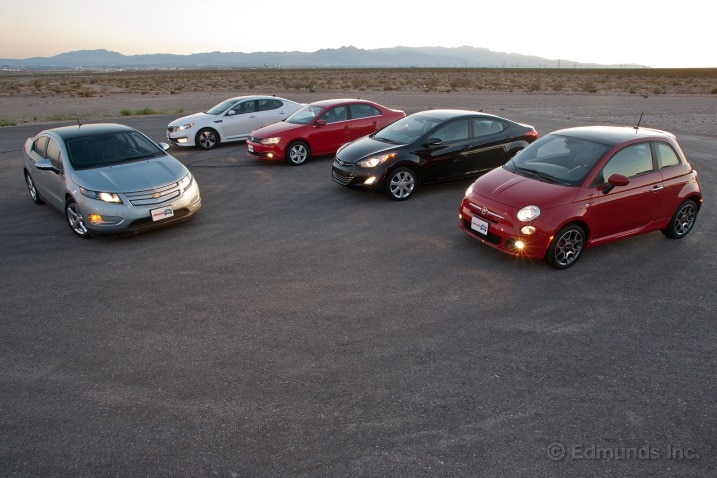So who wins? Well, in terms of mpg, then the Chevrolet Volt takes the rest of the pack to school (as long as you're able to recharge its battery, of course). In terms of overall cost, the Chevy Volt still wins, but there's only a $2.33 difference between it and the last-place Jetta TDI.
The Volt would've been cheaper to run if its engine achieved better fuel economy or ran on regular gas; the use of 87-octane gasoline would've given it a victory of $7.66 instead of just 22 cents. Still, apart from its fuel sipping, the Volt is a nice car to drive. Even when its all-electric charge runs out, the gasoline engine is less noticeable than in a Prius, while the Chevy's sophisticated ride, comfortable seats and well-appointed cabin set it apart from the rest, especially during our lengthy rural route through the desert. Two of our editors picked it as their favorite car, even though they admitted that buying one didn't make financial sense.
The biggest surprise here is the 2012 Fiat 500. It is the only car here to have met or exceeded its EPA mpg estimates on every leg in the test, beating cars that should theoretically have been more efficient. With a simple combination of tiny size, tiny engine and manual transmission, the Fiat managed to prove only 22 cents more expensive to run than the ultra-complex Volt (not to mention about $20,000 cheaper to purchase). Of course, not everyone can live with such a tiny car, but the 500 feels like a real car to drive, even if it might not look like one.
The Kia Optima Hybrid is a significant disappointment given the disparity between its EPA mpg estimates and our real-world results. Still, the advantage the Optima has in running 87-octane gasoline lands it in 3rd place. Its good looks, practical sedan packaging, spacious interior and ample feature content led one of our editors to pick it as his favorite. Of course, the same attributes apply to the regular, more affordable Kia Optima, which nearly matches the Hybrid's fuel economy, so we'd buy one of those instead.
The Hyundai Elantra came close to its EPA estimate in the city, but fell far below its lofty 40-mpg target on both our highway legs. Yet, of all the cars here, the Elantra is the most "normal." It runs on regular gas, it has a spacious sedan interior and it doesn't rely on power-sapping Eco buttons (like the Optima) or overly conservative transmission programming (like countless other cars) to achieve its thriftiness. Perhaps if the Elantra used such fuel-saving tricks it would produce better EPA numbers, but then it would be worse to drive, and that would be a shame. The Elantra is one of the best compact sedans on the road, 40 mpg or no.
Finally, the trusty Volkswagen Jetta TDI brings up the rear because diesel fuel is a good 10 cents per gallon more expensive than premium at the moment. In a year, diesel could be cheaper or a buck pricier; you just never know. What we do know is that the diesel-powered VW Jetta is one of the simplest ways to save fuel, and the car has one of the lowest price tags. We're not especially keen on the Jetta sedan's recent redesign, but two of our editors still picked the TDI as the car they'd happily take home (even if they'd pay a few cents more to get there).
In the end, this test showed us three things. First, figuring out just how thrifty the 2012 Chevrolet Volt is requires a mathematician and a whole lot of perspective. Second, carmakers seem to be figuring out how to maximize results in the EPA test, so when you compare your car's real-world fuel economy with its EPA ratings, well, your mileage may vary, as the expression goes. And finally, this fourth Fuel-Sipper Smackdown has shown us that it's never been easier to find a car that will roll out of your driveway and get really great fuel economy.


 by
by 


